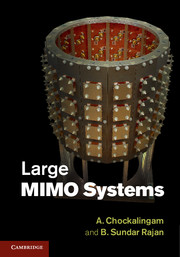Book contents
- Frontmatter
- Dedication
- Contents
- Preface
- Acknowledgments
- Abbreviations
- Notation
- 1 Introduction
- 2 Large MIMO systems
- 3 MIMO encoding
- 4 MIMO detection
- 5 Detection based on local search
- 6 Detection based on probabilistic data association (PDA)
- 7 Detection/decoding based on message passing on graphical models
- 8 Detection based on MCMC techniques
- 9 Channel estimation in large MIMO systems
- 10 Precoding in large MIMO systems
- 11 MIMO channel models
- 12 Large MIMO testbeds
- Author index
- Subject index
- References
12 - Large MIMO testbeds
Published online by Cambridge University Press: 18 December 2013
- Frontmatter
- Dedication
- Contents
- Preface
- Acknowledgments
- Abbreviations
- Notation
- 1 Introduction
- 2 Large MIMO systems
- 3 MIMO encoding
- 4 MIMO detection
- 5 Detection based on local search
- 6 Detection based on probabilistic data association (PDA)
- 7 Detection/decoding based on message passing on graphical models
- 8 Detection based on MCMC techniques
- 9 Channel estimation in large MIMO systems
- 10 Precoding in large MIMO systems
- 11 MIMO channel models
- 12 Large MIMO testbeds
- Author index
- Subject index
- References
Summary
As in any new or emerging technology, demonstrators, testbeds, and prototypes play an important role in the development of large MIMO systems. The terms demonstrators, testbeds, and prototypes are often used loosely and interchangeably to refer to practical proof-of-concept-like implementations. The following broad definitions from [1],[2] bring out some key differences between them.
• A demonstrator is meant primarily to showcase and demonstrate technology to customers. Generally, it involves implementation of a new idea, concept, or standard that has been already established and has been finalized to some extent. Therefore, the requirements on functionality and design time are more important than scalability.
• A testbed is meant for research in general. It is a platform that allows the testing or verification of new algorithms or ideas under real-world conditions. Therefore, testbeds are expected to be more modular, scalable, and extendable.
• A prototype is meant to be serve as the initial realization of a research idea or a standard in real time, as a reference, a proof-of-concept, or a platform for future developments and improvements. It is often intended to evolve a prototype into a product.
From these definitions, one can see that testbeds and prototypes can play crucial roles in the research and development phase. While prototypes need necessarily to operate in real time, a testbed can be a real-time testbed or a non-real-time (offline) testbed depending on the available resources in comparison with the real-time computation need.
Information
- Type
- Chapter
- Information
- Large MIMO Systems , pp. 285 - 296Publisher: Cambridge University PressPrint publication year: 2014
